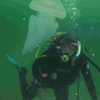General Description
Saucer-shaped jellyfish with short arms underneath that extend from the mouth to the edge of the bell. Many short, fine tentacles are attached to the arms and the edge of the bell. Four white circles inside (internal gonads), visible through the transparent bell. Colour variable, generally bluish in Australia. Bell usually 20 cm across, up to 40 cm across.
Biology
Moon Jellyfish females carry groups of developing young on their arms. They are sought after for display in aquariums. The species in Victoria was thought to be the same as one found all over the world, Aurelia aurita, however DNA testing revealed that our Moon Jellyfish may actually be at least 7 different species.
Habitat
Open water and estuaries, may be found washed ashore.
Open water
Distribution guide
Australia.
Species Group
Jellyfishes and allies › Jellyfishes
Depth
Shore (0-1 m)
Shallow (1-30 m)
Water Column
Max Size
20 cm
Diet
Carnivore
Harmful
Minor sting possible.
Commercial Species
No
Global Dispersal
Native to Australia
Identify
Conservation Status
- DSE Advisory List : Not listed
- EPBC Act 1999 : Not listed
- IUCN Red List : Not listed





